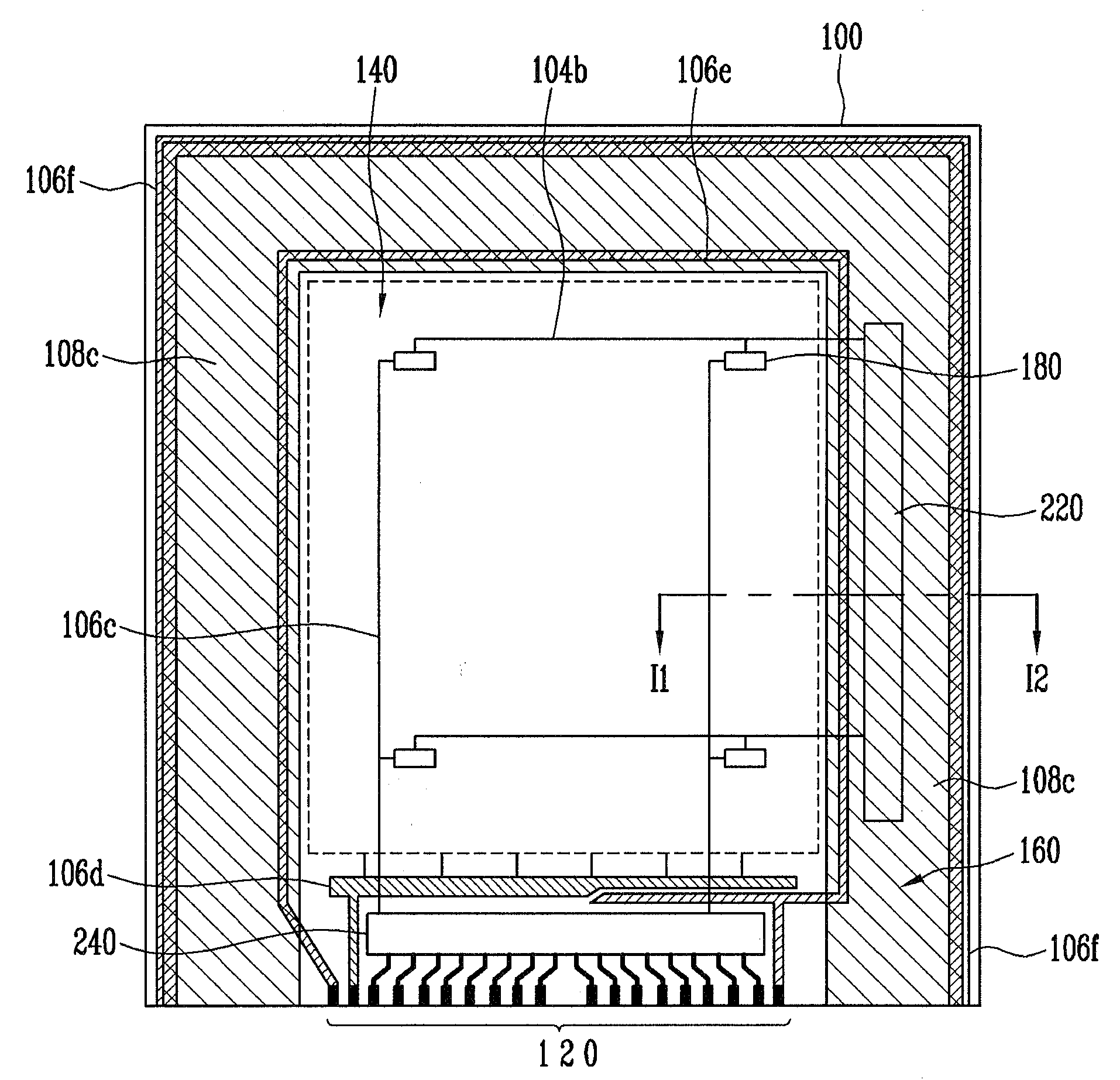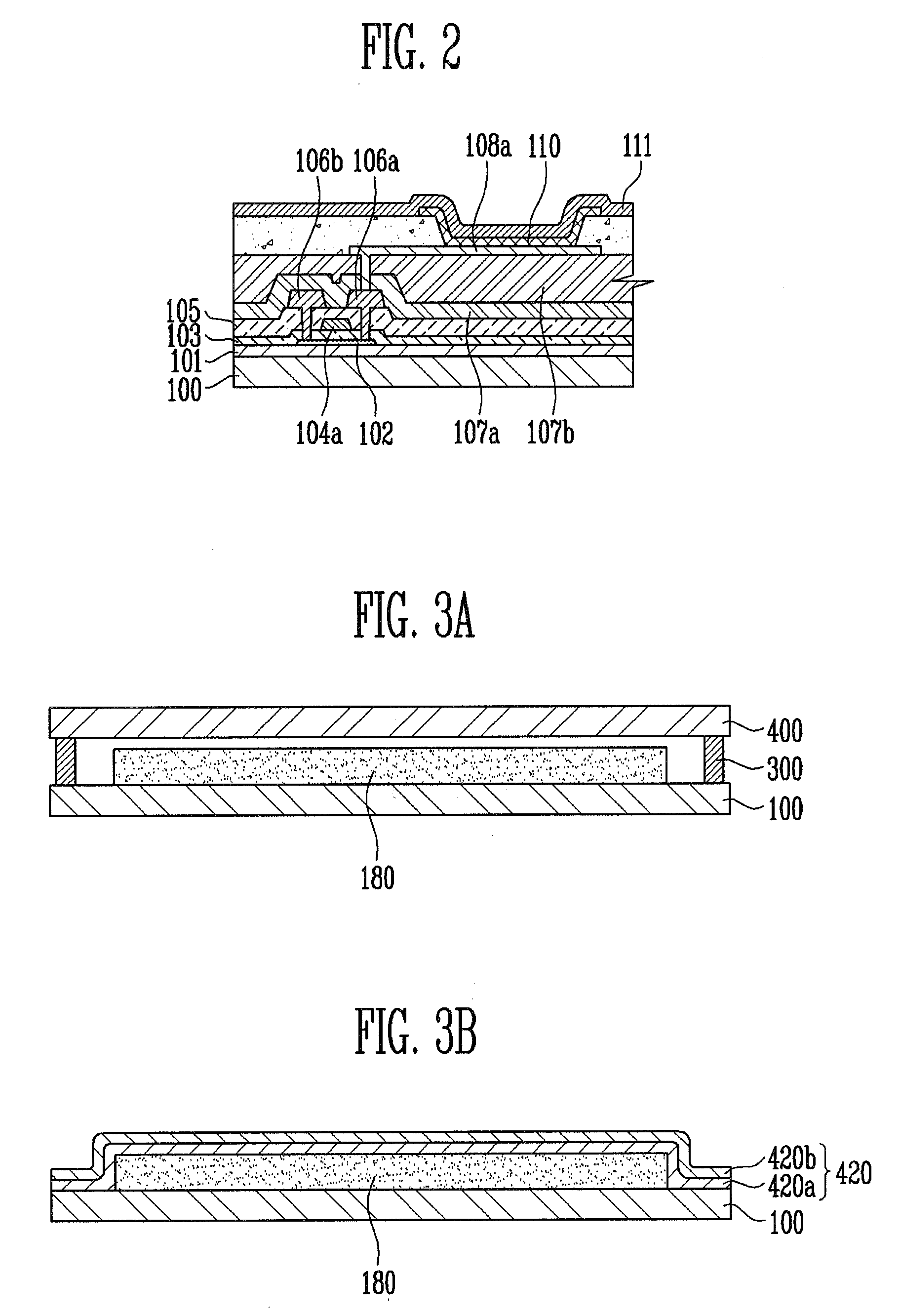Organic light emitting display and method of manufacturing the same
a technology of light-emitting display and organic material, which is applied in the manufacture of electric discharge tubes/lamps, discharge tubes luminescnet screens, electrode systems, etc., can solve the problems of limited effectiveness in preventing (or reducing) damage generated during the use of organic light-emitting displays
- Summary
- Abstract
- Description
- Claims
- Application Information
AI Technical Summary
Benefits of technology
Problems solved by technology
Method used
Image
Examples
first embodiment
[0033]FIG. 4 is a sectional view schematically illustrating an organic light emitting display according to the present invention and is a sectional view taken along the I1-I2 of FIG. 1.
[0034]A buffer layer 101 is formed on the substrate 100 in both the pixel region 140 and the non-pixel region 160. A semiconductor layer 102 that provides an active layer is formed on the buffer layer 101. The semiconductor layer 102 formed in the pixel region 140 provides the active layer of a TFT for driving the OLED 180, and the semiconductor layer 102 formed in the non-pixel region 160 provides the active layer of a TFT that constitutes the driving circuit unit.
[0035]The gate insulating layer 103 is formed in the pixel region 140 and the non-pixel region 160 and on the semiconductor layer 102, and the gate electrode 104a is formed on the gate insulating layer 103 on the semiconductor layer 102. Here, the scan line 104b coupled to the gate electrode 104a is formed in the pixel region 140, and the s...
second embodiment
[0039]FIG. 5 is a sectional view schematically illustrating an organic light emitting display according to the present invention and is a sectional view taken along the line I1-I2 of FIG. 1.
[0040]The organic light emitting display according to the second embodiment of the present invention has substantially the same structure as the organic light emitting display according to the first embodiment. However, the light shielding layer 108c of the non-pixel region 160 is covered with a protecting layer 109 formed of an organic layer.
[0041]As described in the first embodiment, when the shielding layer 108c is formed on the planarizing layer 107b formed of acryl, the attachment state between the planarizing layer 107b and the shielding layer 108c may deteriorate due to the weak layer structure of acryl. Therefore, the shielding layer 108c is covered with the protecting layer 109 so that the attachment state between the planarizing layer 107b and the shielding layer 108c can be maintained ...
third embodiment
[0043]FIG. 6 is a sectional view schematically illustrating an organic light emitting display according to the present invention and is taken along the line I1-I2 of FIG. 1.
[0044]The organic light emitting display according to the third embodiment of the present invention has substantially the same structure as the structure of the organic light emitting display according to the first embodiment. However, the cathode electrode 111 is extended to the top of the shielding layer 108c (or is extended to be on the shielding layer 108c). Here, the pixel defining layer 109 can reside between the cathode electrode 111 and the shielding layer 108c in the remaining part excluding the contacting part between the cathode electrode 111 and the shielding layer 108c.
[0045]The cathode electrode 111 is extended to the top of the shielding layer 108c (or is extended to be on the shielding layer 108c) to form an electric contact in the overlapping part between the cathode electrode 111 and the shield...
PUM
 Login to View More
Login to View More Abstract
Description
Claims
Application Information
 Login to View More
Login to View More - R&D
- Intellectual Property
- Life Sciences
- Materials
- Tech Scout
- Unparalleled Data Quality
- Higher Quality Content
- 60% Fewer Hallucinations
Browse by: Latest US Patents, China's latest patents, Technical Efficacy Thesaurus, Application Domain, Technology Topic, Popular Technical Reports.
© 2025 PatSnap. All rights reserved.Legal|Privacy policy|Modern Slavery Act Transparency Statement|Sitemap|About US| Contact US: help@patsnap.com



